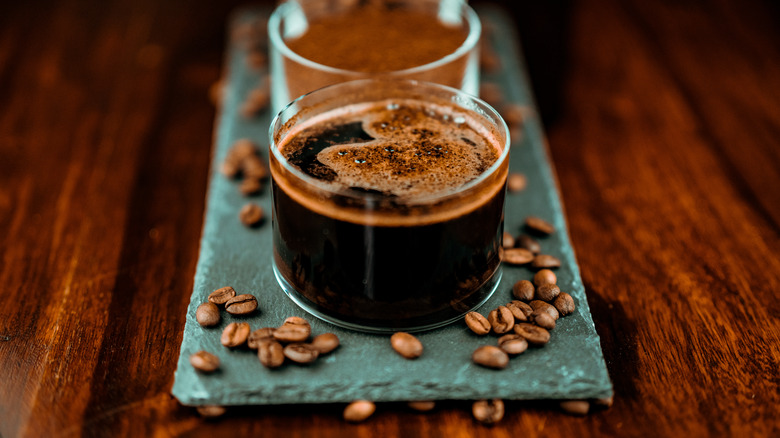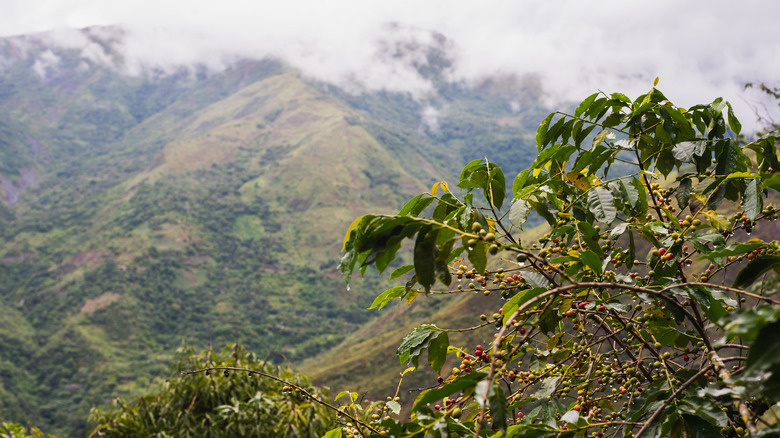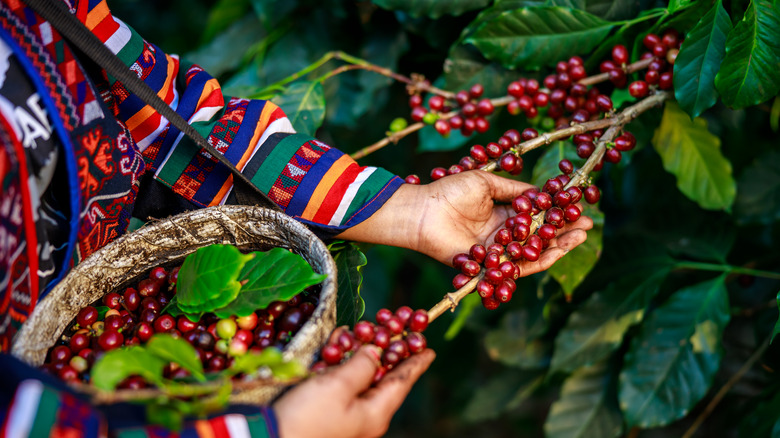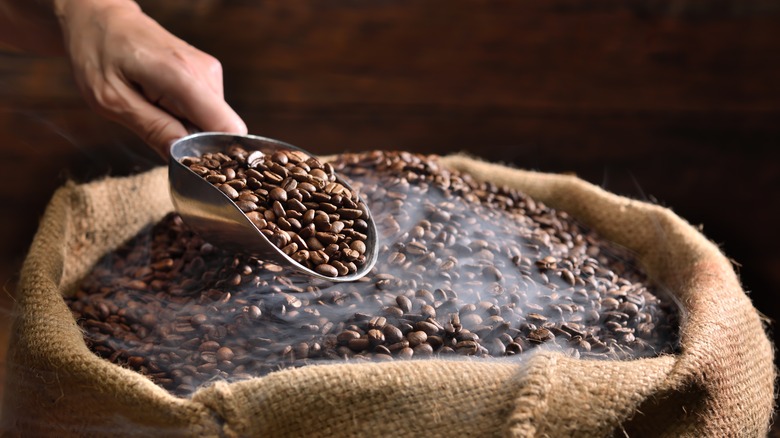What Makes Panama's Geisha Coffee Unique (& Why Is It So Expensive)?
Coffee is a global commodity — grown in over 70 countries and consumed in many more. And while there are a dazzling variety of beans to choose from, the largest output is centered in a few select regions. Brazil leads volumetric output, with 37% of the market share, and Vietnam follows with 17%, per a 2020 report from the World Economic Forum. However, these producers have little overlap with the specialty coffee market. For example, in Vietnam, less flavorful Robusta coffee makes up 95% of the grown product, with only an emerging specialty scene, reports Sucafina.
This stems from the fact that elite specialty coffee beans can only be grown in small-scale volumes, with extra care to every step of the harvesting methods. Techniques are laborious — berries are hand-picked and sorted, with deformities discarded. And there's no coffee that better demonstrates such attention to detail than Panama's geisha. Winning competitions and breaking price records, many consider it the world's best. Let's dive into why.
What is Panamanian geisha coffee?
Panama's geisha coffee is one of the world's most lucrative coffee varieties. Fetching ever-increasing prices (a whopping $2,500 a pound in 2021!), it's esteemed not only for the beans' rarity but also their flavor. With an ultra-aromatic taste involving notes of tropical fruit, peach, and bergamot, the coffee dominates competitions, often scored as some of the best worldwide. Long grown intermixed with other coffee cherries, the outstanding berry was only isolated in 2004, generating a buzz that hasn't faded away since. Nowadays, the delicious and disease-resistant varietal is becoming more ubiquitous. Spreading globally to countries like Colombia, Thailand, and Malawi, there are more accessible variants, but the Panamanian originator continues to generate acclaim, notes Coffee Chronicler.
Part of the coffee's allure is its unique growing conditions. This Arabica subspecies is a hybrid coffee originally from Ethiopia — an explanation for why its palette matches beans from the East African nation. Grown in Panamian highlands over 5,000 feet, the plant has smaller leaves and thinner roots, making it difficult to cultivate a large volume. Yet the flavor it generates is dependably delicious and complex, with lots consistently scoring in the highest ranks of the Specialty Coffee Association. To add to the intrigue, it all started from one farm named Hacienda la Esmeralda, notes Sagebrush Unroasted. Here's how it got its roots in Panama.
The history of Panama's geisha coffee
The coffee traces back to 1936 when a British captain isolated the wild coffee in the Gesha region of Ethiopia. The seeds were bagged and exported to Central America due to their noted resistance to rust infections. Genetic research confirms this trajectory — Panamanian geisha coffees bear a nearly identical resemblance to wild samples from Gesha, Ethiopia. Take note this coffee breed is occasionally called gesha, which aligns with the name of its original region. The additional "i" was instead a result of an accidental misnaming or purposeful exoticism, notes Sprudge.
Throughout most of its existence in Latin America, geisha received no special attention; it was simply blended with other varieties across plantations. Its rise towards distinction was initiated in the 1990s when the coffee farm Hacienda la Esmeralda in Panama expanded its coffee harvesting to a lot at a higher elevation. Owner Daniel Peterson noticed geisha's resistance to disease and filled the farm with this new seed at an altitude never harvested before. It took nearly another decade for the coffee to gain recognition for its aromatic attributes. While preparing for the 2004 Panamanian coffee competition, the Petersons isolated the high-altitude geisha beans separate from the rest of the farm. The subsequent cupping shocked the judges and put Panama's geisha coffee on the map (via Hacienda La Esmeralda).
The flavor of geisha coffee
Much like fine wine, Panama geisha's elegant flavor encapsulates its origins and careful production techniques. It has a trademark essence, exhibiting a light body accompanied by a highly aromatic flavor. The first tasting note is akin to jasmine, continued by a balanced tartness that opens to a bouquet of fruit. Frequent descriptors include papaya, mango, berries, and oranges — all sweet, juicy, and delectable descriptors. Bergamot is often noted as an aftertaste on the palate, notes Espresso & Coffee Guide.
The best way to do geisha beans justice is through simpler brewing methods. The less complicated the equipment, the easier it is to fine-tune every factor — in turn producing a cleaner cup. A method like French press or pour over is best suited, with extra care to the water quality, temperature, and ratio. The result should be refined, floral, and almost tea-like, per Japanese Coffee Co. Balanced and aromatic, the coffee's light nature may even throw off drinkers used to more traditional, robust cups. Just don't expect to find Panama's geisha coffee easily available. With a propensity to time-consuming manual brewing and a hefty price tag, the bean is not popular in a café setting.
Other varieties of geisha coffee
While geisha coffee does exhibit hallmark characteristics, there's a substantial amount of variability in how it tastes. Many factors, including the bean's growing location, processing, and roasting, impact the resulting cup. As a beverage demonstrating terroir, even differences on a single farm, like when the coffee is picked, its soil, and the season also translate to the resultant cup. Factor in that Panama's geisha is subject to all three processing types — natural, washed, and honey, and it's fair to say the beans encapsulate a multitude of variability.
As described in a coffee tasting by Coffee Navigated, geisha from outside of Panama exhibit a totally different flavor palate. Even the beans from Gesha, Ethiopia, the varietal's genetic origin, result in a bolder, funkier palette than what geishas are known for. The cupping involved the varietal from all around the world, but unsurprisingly one stood above the rest — Panama's high-elevation varietal.




